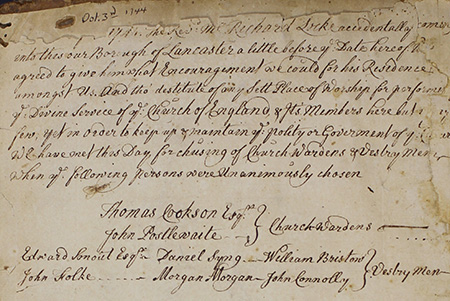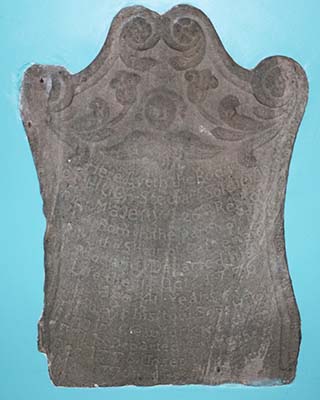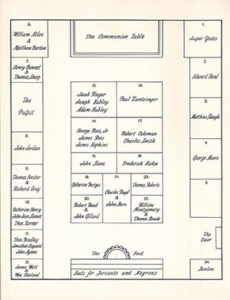Saint James 1744 – 1799
For the first 50 years of its life, Saint James struggled to establish and maintain its identity within the Anglican tradition. Officially founded in 1744 as a Church of England parish, it initially lacked its own building and was served by clergy who were SPG missionaries. Later its parishioners had to negotiate the Revolutionary War years which produced deep divisions, the removal of its rector and the closure of the church itself. Following American independence from Great Britain, Saint James played an important role in the creation of the Protestant Episcopal Church.
1744 – 1799 | 1800 – 1899 | 1900 – Present
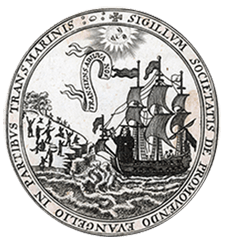
King William III charters the Society for the
Propagation of the Gospel
Saint James was created by the missionary vision of the Society for the Propagation of the Gospel in Foreign Parts (SPG). Founded in 1701, the lofty ideals of SPG were to provide Christian ministry to British people overseas and to evangelize the “New World.”
-
Saint James is formally organized
Saint James is formally organized with Rev. Richard Locke (a missionary from the SPG), church wardens and vestrymen. Services are held in the court house. Later that year, James Hamilton gives three town lots to the Saint James Parish so a church could be built and a churchyard could be established. Hamilton also made a subscription toward the erection of a church building. Click image to enlarge.
-
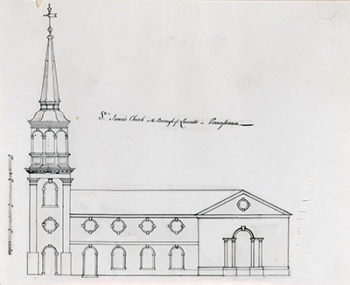
Work begins on stone church
This is the only image purportedly depicting the original stone church of Saint James but it may never have been completed in this form. Built between 1745 and 1753, the original building is described in church records as a stone chapel, measuring 44 feet long and 34 feet wide. The church in this drawing does not have those dimensions. One explanation for this is that it may have been made produced by church members or local contractors as a vision for Saint James and sent to London with an appeal for financial support.
However, in a lithograph of Lancaster dated 1800 the church is depicted with a steeple, added in 1762, similar to the one in the drawing. In whatever form it came to be, the original stone church was demolished in 1819 to make way for the core of the building that exists today.
-
George Craig makes his home in Lancaster
The Rev. George Craig was appointed to be a SPG missionary in Pennsylvania and New Jersey before he traveled from England to America. On arrival he decided to make Lancaster the headquarters for his ministry. Under his leadership the first church building was completed. Ill-health and disagreements with the vestry led Craig to leave Saint James in 1759.
-
Free school for German children opens
A free school for German children was opened in Lancaster and funded by the SPG at the suggestion of the Rev. William Smith. He was the first provost of the College of Philadelphia (later University of Pennsylvania), and he believed that such schools following the French and Indian War would prevent German immigrants from being led away from English interests by the French. Samuel Magaw was the headmaster. He later became rector of St. Paul’s Church in Philadelphia and Vice Provost of the University of Pennsylvania (1782-91).
-
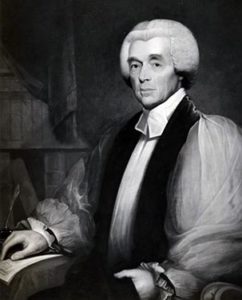
Charles Inglis travels to England to be ordained
Formerly a teacher at the Free School for German children in Lancaster, he was recommended for holy orders by the rector of Saint James, Rev. George Craig. He traveled to England to be ordained as before the revolution there were no American bishops. On his return, he served in Delaware and as rector of Trinity Church, Wall Street, New York. He was a vociferous opponent of American independence from Great Britain. He later became the Bishop of Nova Scotia in Canada, the first colonial bishop in the British Empire.
-
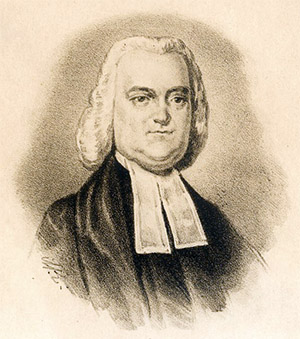 Thomas Barton is appointed as rector
Thomas Barton is appointed as rectorThe Rev. Thomas Barton was a SPG missionary of Anglo-Irish descent. Before he arrived in Lancaster, he had served as an itinerant missionary for York and Cumberland counties and as a chaplain under General John Forbes in the march on Fort Duquesne in 1758. He was appointed rector of Saint James and missionary to the congregation of Pequea (now Compass) and Churchtown in 1759. Like his two predecessors he was a circuit-riding priest. He also ministered, in Columbia, Morgantown and Reading. His home for 19 years was on the southeast corner of Orange and Lime streets, Lancaster.
-
First convention of the Church of England in the American Colonies
The first ever convention of Church of England parishes in the colonies was held in 1760 in Philadelphia. Barton attended along with other clergy from Delaware, New Jersey and Pennsylvania. This was the first time that American Anglicans had come together to discuss common issues. Barton prepared the convention’s letters to the archbishop of Canterbury and bishop of London as well as those to Thomas and Richard Penn, proprietaries of the Province of Pennsylvania.
-
Saint James has a fundraiser for a steeple
Lotteries were a common way to raise funds for church building projects in this era. In 1761, two lotteries brought in sufficient money to repair the church building and construct a steeple at the west end of the church.
-
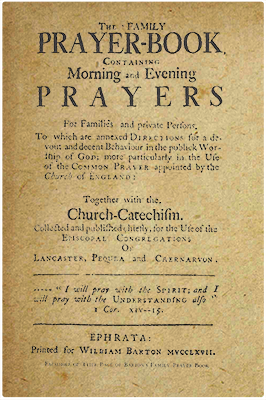
Barton’s Family Prayer Book is published
The Rev. Thomas Barton’s prayer book was based on the Church of England’s Book of Common Prayer (1662) and was intended to foster private prayer in the homes of his three congregations: Saint James Church, Lancaster; Saint John’s Episcopal Church, Pequea (now Compass); and Bangor Episcopal Church, Churchtown. He believed that private prayer was the best preparation for public prayer at church and that parents lacked knowledge and confidence to make prayer a regular part of family life. Among the prayers in his book were some specifically designed to be used by children, young people and servants. This book was printed by the Cloister Press at the Seventh Day Baptist Community, Ephrata.
-
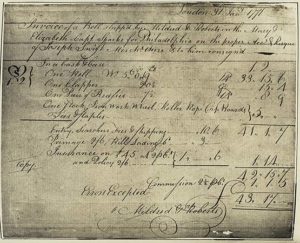 Saint James gets a bell
Saint James gets a bellInitially, Saint James only had a hand bell for calling the congregation together. In May 1771, a bell from Mildred and Roberts, bell founders of London, was installed after being shipped from England to Philadelphia on the ship, HMS Mary and Elizabeth. This bell was funded by Saint James parishioners and people from other churches. It was recast in 1858 and is still in use today. Click image to enlarge.
-
School for the poor is established
In 1771 Saint James established a school for “children of poor persons in communion with the Church of England as were not able to pay for their tuition” and employed Joseph Rathell as its first school teacher. Children were taught reading, writing, arithmetic, the catechism and religion. Several Africans however, “belonging to different families of the Church”, were taught separately on a Sunday evening.
-
Saint James parishioners work to repeal unjust lawsenacted by British Parliament
A local Committee of Correspondence was set up in Lancaster to work with other colonists for the repeal of unjust laws enacted by the British Parliament. Among its members were Saint James parishioners including: Edward Shippen, George Ross, Jasper Yeates, Matthias Slough, William Atlee and William Henry.
-
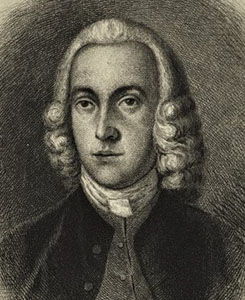 George Ross Signs the Declaration of Independence
George Ross Signs the Declaration of IndependenceGeorge Ross, the son of an Anglican clergyman, settled in Lancaster in 1751 and soon served as a vestryman and churchwarden. A lawyer by profession and initially a Tory, he served as Crown Prosecutor for Cumberland County for 12 years and was elected to the provincial legislature in 1768. There, his sympathies began to change, and he became a strong supporter of the colonial assemblies in their disputes with the British Parliament.
Ross joined the Lancaster Committee of Correspondence in 1774 and was elected to the Continental Congress in 1774, 1776, and 1777. He also served as a colonel in the Pennsylvania militia (1775–1776). George Ross was the last of the Pennsylvania delegation to sign the Declaration of Independence.
Later he became vice president of the Pennsylvania Constitutional Convention and was the Judge of the Admiralty Court of Pennsylvania in 1779. He died the same year and is buried at Christ Church Burial Ground in Philadelphia.
-
 How Independence affected Saint James
How Independence affected Saint JamesAlthough he did not know it, Thomas Barton’s last public service as rector of Saint James was to be on Sunday, June 23 1776. With many in the congregation ardent patriots, after the American Declaration of Independence, he could no longer conduct services using the Book of Common Prayer.
His ordination vows had included an oath of allegiance of the British Sovereign as head of the Church of England and to only use the Book of Common Prayer which included prayers for King George III and the royal family. As a result, Saint James was closed, in the words of Barton “to avoid the fury of the populace”.
In 1778, Jasper Yeates, the treasurer, paid to have the windows boarded up and padlocks for the gates and belfry doors.
-
British prisoners are buried in unmarked graves in churchyard
During the Revolutionary War, some of the British prisoners, quartered in Lancaster, died and were buried in the churchyard. Only Hugh Stewart had a headstone, and this can be seen in the wall in the corridor along the chapel. Click image to enlarge.
-
 Barton leaves Pennsylvania
Barton leaves PennsylvaniaAfter refusing to take the oath of allegiance required by law, Barton and his wife were given permission to move to New York, then occupied by the British, on condition that they not return to Pennsylvania. Permission was granted by the Supreme Executive Council of the Commonwealth of Pennsylvania, and Barton sold his house and left town with his second wife Sarah DeNormandie. Barton later died in 1780 in New York.
-
Joseph Hutchins is appointed rector.
The boards from the windows of Saint James were removed, and the church reopened for worship. William Atlee, a vestryman and a judge of the Supreme Court of Pennsylvania, was selected to be warden, and the congregation chose Jasper Yeates for their warden. These men had held the same positions prior to Independence. The vestry then elected John Miller, as sexton at a yearly salary of £5. He was also allowed to charge fees for digging the graves of deceased parishioners.
-
William White calls a meeting to discuss the future of the church
In May 1784 the Rev. Joseph Hutchins and some of his parishioners attended a meeting called by William White, then rector of Christ Church, Philadelphia, to begin discussions about the American church following the signing of the Treaty of Paris which ended the War of Independence.
-
Saint James representative go to Philadelphia
Representatives from Saint James and other local churches met at Christ Church, Philadelphia to create the Diocese of Pennsylvania. Prior to the Revolution, there were no American dioceses or bishops. Local churches were part of the Church of England overseen by the Bishop of London which required ordination candidates to cross the Atlantic in order to be ordained. Following the revolution and the breaking of all ties with Britain, there was a pastoral and practical need for bishops and dioceses.
-
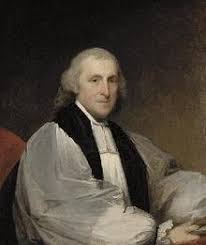
Diocesan Convention elects William White as first bishop of Diocese of Pennsylvania
In 1787 the Rev. Dr. William White, Rector of Christ Church, Philadelphia, was consecrated at Lambeth Palace, London. He thereby became the first Bishop of Pennsylvania and the second bishop (after Bishop Samuel Seabury of Connecticut) in the newly formed Episcopal Church of the United States.
-
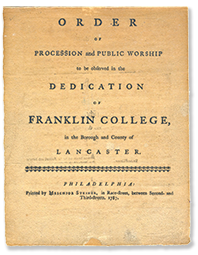
Joseph Hutchins is one of the first trustees of Franklin College
The Rev. Joseph Hutchins was named a trustee of Franklin College in its charter of 1787 and elected professor of English language and literature. The mission of Franklin College was to educate the German youth of central Pennsylvania and help in the diffusion of “knowledge through every part of the State, in order to preserve our present republican system of government, as well as to promote these improvements in the arts and sciences which alone render nations respectable, great and happy.”
At that time, Lancaster was largely German-speaking, but English was the official language of the community. Hutchins was unpopular with many German speaking pastors as, on the occasion of the opening of the College, he gave an address in Trinity Lutheran Church in which he strongly advocated the necessity of learning of English for all American citizens.
-
The First Episcopal Book of Common Prayer
Following Independence, an American version of the Book of Common Prayer was required to reflect the identity of a church that was separate but in communion with the Church of England. In 1789, General Convention (created in 1785 as the governing body of the Protestant Episcopal Church) adopted its own Book of Common Prayer. Both the Rectors Joseph Hutchins but especially Joseph Clarkson took an active part in adapting the English Book of Common Prayer for use by the Church in the United States.
-
Elisha Septimus Rigg becomes rector
Within a month of being ordained by the Bishop of Pennsylvania, the Rt. Rev. Dr. William White, Rigg became rector of Saint James in January 1789. He later married Miss Jane Atlee, daughter of the rector’s warden William Atlee.
-
Seating Plan of Church 1791
Like most Episcopal churches at this time, the expenses of running Saint James were largely met by wealthy families paying an annual rent to sit in an assigned pew. This plan shows the location of each pew in 1791. Social prominence and racial segregation is clearly shown. The wealthiest men sat front and center with their families. Class and racial segregation is demonstrated by designated seating at the back of the church for ‘servants and negroes’.
From its foundation, people of African descent worshipped at Saint James both as enslaved and ‘free’ people. Some of our most famous parishioners held people of African descent in bonded servitude. The list of such parishioners is very long but includes: Robert Coleman, the Grubb family, Edward Hand, George Ross, Edward Shippen, Jasper Yeates and Paul Zantzinger. Many others indirectly profited from an economy built on the nightmare of slavery and the slave trade.
Click image to enlarge.
-
A Female Academy opens in Lancaster
In keeping with former Saint James rectors’ interest in education, the Rev. Elisha Rigg opened a “female seminary” for young ladies. Subjects of study included arithmetic, English grammar, geography, history, reading, writing and “sketches of the nature and use of several other sciences.” Embroidery and drawing were added in 1796. The Academy also had a house where pupils could board.
-
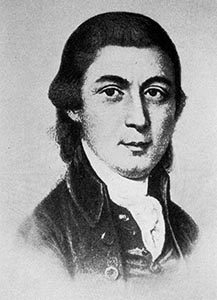
Joseph Clarkson becomes rector
Joseph Clarkson was the third son of the distinguished physician Dr. Gerardus Clarkson of Philadelphia. He was the first candidate to be ordained by Bishop William White—at his first ordination in America—in Christ Church, Philadelphia.
Joseph Clarkson served as Saint James rector 1799-1830 until his death in 1830. In addition to his parish duties, he was a founder of the Lancaster Bible Society and the first secretary of the House of Bishops of the Episcopal Church. Under his leadership the original stone church was demolished and a new brick building constructed in 1820.
1744 – 1799 | 1800 – 1899 | 1900 – Present
